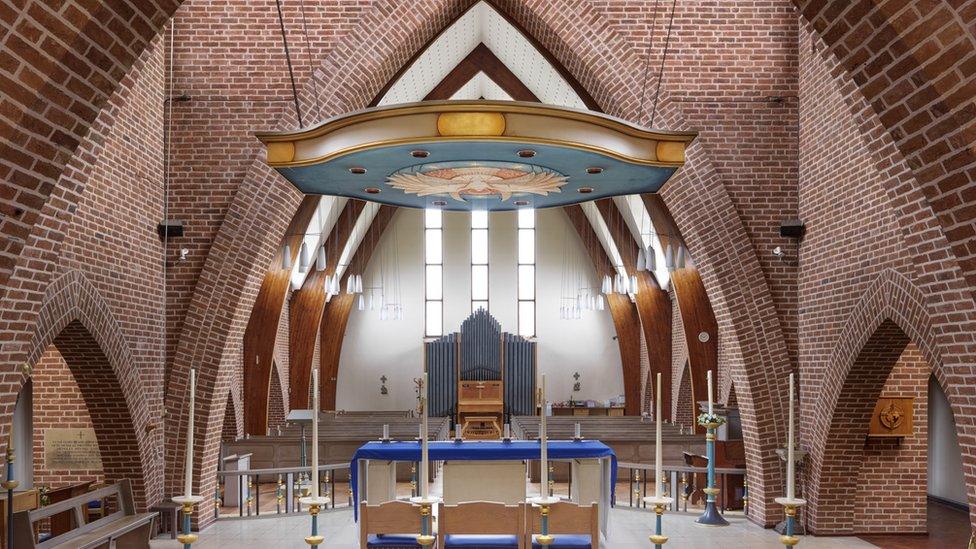Ancient car wash and boat-church on Historic England Heritage List
- Published

Among the entries is the Church of St Nicholas in Lancashire, the architecture of which is inspired by the upturned keel of a seafaring vessel
England's earliest-known car wash and a church inspired by an upturned boat are among 16 sites that have been added to the National Heritage List.
Other sites include a rare WW2 radar station in Northumberland, and a railway pub that was a prototype for a station.
In total this year, 227 places have been added to the list.
Historic England says the sites give a "window into our rich and varied historic environment".
A carriage wash in Hertfordshire dating to 1600 and believed to be England's earliest known 'modern day car wash' was added, as well as a railway pub built by the Stockton & Darlington Railway.
Fleetwood's maritime connections are reflected in the striking post-war design of the Church of St Nicholas
The Church of St Nicholas in Fleetwood, Lancashire, is a Grade II-listed church that is a rare example in the north of England.
Its design in the form of an upturned boat is dominated by sheer tower walls and copper-clad roofs, with unusual triangular windows representing sails.
The triangular windows on the Church of St Nicholas represent sails
First 'modern-day car wash'
"Carriage splash" dates from 1600 and is one of only four such structures known in England
Barkway Carriage Wash, also known as "carriage splash", in Royston, Hertfordshire, was an important stopover en route from London to Cambridge and the north of England, during the heyday of the coaching era.
The Dome in Doncaster Leisure Park is an architecturally striking and inventive late-1980s leisure centre
When it was built in 1989, The Dome in Doncaster, South Yorkshire, was the largest leisure centre in Europe, and attracted over a million visitors a year.
The Dome offers a range of leisure activities
Designed around a huge central atrium, it welcomes visitors with a swimming pool, ice rink, sports and events halls, and squash courts.
Radar stations like these played a crucial role in the defence of the nation during World War Two
Chain 91热爆 Low Radar Station in Craster, Northumberland, was built in 1941 to detect and monitor the movement of German shipping in the light of a potential invasion of Britain in the early years of World War Two.
Honorary members of Beaconsfield Golf clubhouse include Luke Donald, former world number one and current Ryder Cup Captain
The clubhouse at Beaconsfield Golf Club in Buckinghamshire was built between 1913 and 1914, and is a rare example of a purpose-built Arts and Crafts clubhouse from the first great period of golf course expansion in England between 1890 and 1914.
Beaconsfield Golf Club has a rare Arts and Crafts clubhouse
The Railway Tavern in Darlington was one of three railway pubs built in 1826 as a proto-railway station
The Railway Tavern public house in Darlington was built in 1826 by the pioneering Stockton & Darlington Railway (S&DR), and was in effect a proto-railway station as it came before the concept of the railway station had fully developed.
The Railway Tavern did not develop into a fully functioning railway station, however, it is the only one of the three proto-railway pubs built that is still operating
Duncan Wilson, chief executive of Historic England, said they'd examined and protected "amazing" sites this year, which offer a window into England's "rich and varied historic environment".
"The festive period is a great time to find out more about the historic places all around us," he said.
"I encourage everyone to explore the heritage on our doorsteps and to add what they discover to our for everyone to see and enjoy."
All photos subject to copyright
Related topics
- Published29 November 2023
- Published18 November 2023